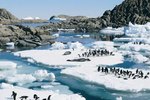
Polar bears live on the continents of North America and Eurasia, where they live mostly solitary lives dining on fresh seal. At the top of the food chain in their polar habitat, these large marine mammals evolved from the smaller brown bear and are well-adapted to the often frigid temperatures of their Arctic homes.
Geographic Range
While most polar bears live north of the Arctic Circle, some can be found as far south as Alaska and Hudson Bay, Canada. In colder years when pack ice is heavy, polar bears will even travel as far south as Southern Labrador, Newfoundland and the Gulf of St. Lawrence in Canada, and the Norwegian mainland. Most years, polar bears stay further north, however, roaming sea ice off the coasts of Canada, Greenland, Russia and some islands north of Norway.
Habitat
Although polar bears have been found as far as 124 miles inland, most stick to the coasts for easy access to the sea ice where they are most comfortable. Polar bears are accomplished swimmers; they'll swim long distances from shore to reach the ice sheets they depend on to hunt seals, which are their primary prey. The bears find leads, cracks in the sea ice where seals and other polar marine mammals surface to breathe, and there they wait patiently for an animal to surface so they can attack.
Migration
Polar bears travel throughout the year within their individual home ranges, which can vary in size anywhere between 50,000 square miles and 135,000 square miles, depending on the prevalence of sea ice and size of adjacent landmasses. As the sea ice recedes in the spring and advances in the fall, polar bears undertake more extensive seasonal migrations, following the movement of the ice on which their survival depends. Scientists have tracked polar bears more than 20 miles in a single day for several days at a stretch.
Related Behavior
Polar bears don’t den or hibernate as other bears do, but on particularly cold winters they will shelter beneath the snow in temporary dens, entering states of semi-hibernation called carnivore lethargy. The bear’s heartbeat and metabolism slows, so the bear needs less energy to survive and keep warm, but these periods are not as long as traditional hibernation and the sleep is not as deep. A pregnant female will build a den in a snow bank prior to the arrival of her cubs. She stays in the den throughout the winter, giving birth and caring for her newborns while awaiting spring.
Climate Change
Temperature rise in oceans around the globe have tremendous impact on the polar bear’s habitat and survival. Higher ocean temperatures mean the sea ice melts earlier in the spring and forms later in the fall, giving the bears insufficient time to hunt for seals from their ice platforms. Additionally, as progressively less of the surface of polar waters are covered with ice, polar bears are forced to swim further away from shore to reach the sea ice. Less ice, in terms of area and of duration, means polar bears often must fast for months at a time.
References
Photo Credits
-
Jupiterimages/Photos.com/Getty Images
Writer Bio
Jennifer Mueller began writing and editing professionally in 1995, when she became sports editor of her university's newspaper while also writing a bi-monthly general interest column for an independent tourist publication. Mueller holds a Bachelor of Arts in political science from the University of North Carolina at Asheville and a Juris Doctor from Indiana University Maurer School of Law.




